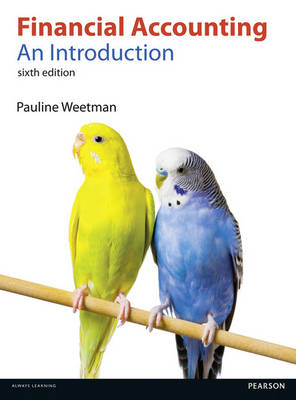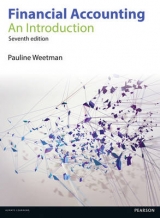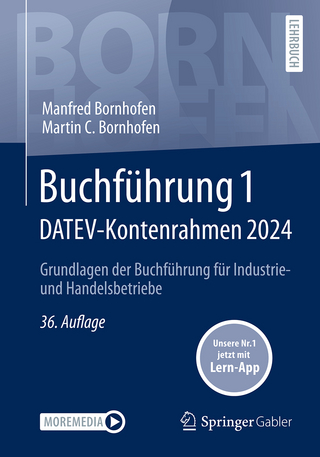
Financial Accounting
Pearson (Verlag)
978-0-273-78925-3 (ISBN)
- Titel erscheint in neuer Auflage
- Artikel merken
The sixth edition retains all of the classic features that have contributed to the book's success: clarity of expression, the focus on the accounting equation, student activities and real-life commentaries running through each chapter, and the inclusion of the Safe and Sure Annual Report as an example of a listed company.
Financial Accounting: an Introduction is aimed at first-level undergraduates on business studies degrees taking introductory financial accounting classes; first-level specialist accounting undergraduate students; introductory core accounting for MBA and postgraduate specialist Masters students (e.g. finance, actuarial studies), focusing on analysis through the accounting equation and a questioning approach to problem solving; and professional courses where accounting is introduced for the first time.
Key features:
Fully up-to-date with International Financial Reporting Standards, IFRS
Experience-driven conversations between two managers are included throughout, providing a practical examination of real life scenarios
New coverage on Corporate Governance
Focuses on specific knowledge outcomes, with end-of-chapter self-evaluation
Questions are graded to test student understanding
New case studies containing examples from real-world companies
Need extra support?
This product is the book alone, and does NOT come with access to MyAccountingLab.
This title can be supported by MyAccountingLab, an online homework and tutorial system which can be used by students for self-directed study or fully integrated into an instructor's course.
You can benefit from MyAccountingLab at a reduced price by purchasing a pack containing a copy of the book and an access card for MyAccountingLab: Buy Financial Accounting: an Introduction with MyAccountingLab access card, 6/e (ISBN 9780273789659). Alternatively, buy access to MyAccountingLab and the eText - an online version of the book - online at www.MyAccountingLab.com.
For educator access, contact your Pearson Account Manager. To find out who your account manager is, visit www.pearsoned.co.uk/replocator
Pauline Weetman BA, BSc (Econ), PhD, CA, FRSE, is Professor of Accounting at the University of Edinburgh, and has extensive experience of teaching at undergraduate and postgraduate level, with previous chairs held at Stirling, Heriot-Watt, Strathclyde and Glasgow Universities. She received the Distinguished Academic Award of the British Accounting Association in 2005. She has convened the examining board of the Institute of Chartered Accountants of Scotland and was formerly Director of Research at ICAS.
Table of Contents
Preface to the sixth edition
Guided tour of the book
Publisher's acknowledgements
Part 1 A conceptual framework: setting the scene
Chapter 1 Who needs accounting?
Real World Case
Learning outcomes
1.1 Introduction
1.2 The development of a conceptual framework
1.3 Framework for the preparation and presentation of financial statement
1.4 Types of business entity
1.5 Users and their information needs
1.6 General purpose or specific purpose financial statements?
1.7 Stewards and agents
1.8 Who needs financial statement?
1.9 Summary
Further reading
Questions
A Testing your understanding
B Application
C Problem solving and evaluation
Activities for study groups
Notes and references
Supplement: introduction to the terminology of business transactions.
Test your understanding
Chapter 2 A systematic approach to financial reporting: the accounting equation
Real World Case
Learning outcomes
2.1 Introduction
2.2 The accounting equation
2.3 Defining assets
2.4 Examples of assets
2.5 Recognition of assets
2.6 Defining liabilities
2.7 Examples of liabilities
2.8 Recognition of liabilities
2.9 Defining the ownership interest
2.10 Recognition
2.11 Changes in the ownership interest
2.12 Assurance for users of financial statement
2.13 Summary
Further reading
Questions
A Testing your understanding
B Application
C Problem solving and evaluation
Activities for study groups
Notes and references
Supplement: debit and credit bookkeeping
Test your understanding
Chapter 3 Financial statements from the accounting equation
Real World Case
Learning outcomes
3.1 Introduction
3.2 Who is in charge of the accounting system?
3.3 The accounting period
3.4 The statement of financial position (balance sheet)
3.5 the income statement (profit and loss account)
3.6 The statement of cash flows
3.7 Usefulness of financial statement
3.8 Summary
Further reading
Questions
A Testing your understanding
B Application
C Problem solving and evaluation
Activities for study groups
Notes and references
Supplement: using the accounting equation to analyse transaction
Test your understanding
Chapter 4 Ensuring the quality of financial statements
Real World Case
Learning outcomes
4.1 Introduction
4.2 Qualitative characteristics of financial statements
4.3 Measurement in financial statements
4.4 Views of prudence
4.5 Regulation of financial reporting
4.6 Reviewing published financial statements
4.7 Summary
Further reading
Questions
A Testing your understanding
B Application
C Problem solving and evaluation
Activities for study groups
Notes and references
Part 2 Reporting the transactions of a business
Chapter 5 Accounting information for service businesses
Real World Case
Learning outcomes
5.1 Introduction
5.2 Analysing transactions using the accounting equation
5.3 Illustration of accounting for a service business
5.4 A process for summarising the transactions: a spreadsheet
5.5 Financial statements as a means of communication
5.6 Summary
Questions
A Test your understanding
B Application
Supplement: recording transactions in ledger accounts - a service business
Test your understanding
Chapter 6 Accounting information for trading businesses
Real World Case
Learning outcomes
6.1 Introduction
6.2 Goods purchased for resale
6.3 Manufacturing goods for resale
6.4 Illustration of accounting for a trading business
6.5 A process for summarising the transactions: a spreadsheet
6.6 Financial statement of M. Carter, wholesaler
6.7 Summary
Questions
A Test your understanding
B Application
Supplement: recording transactions in ledger accounts: a trading business
Test your understanding
Part 3 Recognition in financial statements
Chapter 7 Published financial statements
Real World Case
Learning outcomes
7.1 Introduction
7.2 International influences
7.3 Accounting framework
7.4 Statement of financial position (balance sheet)
7.5 Income statement (profit and loss account)
7.6 Statement of cash flows
7.7 Group structure of companies
7.8 Group financial statements
7.9 Small and medium-sized entities (SMEs)
7.10 Beyond the annual report
7.11 Summary
Further reading
Useful websites
Questions
A Testing your understanding
B Application
C Problem solving and evaluation
Activities for study groups
Notes and references
Suppleemnt 7.1 information to be presented on the face of the balance sheet, as required by IAS 1
Supplement 7.2: balance sheet format 1, as prescribed by the Companies Act 2006
Supplement 7.3: information to be presented on the face of the Income Statement as required by IAS 1
Supplement 7.4: UK Companies Act profit and loss account format 1 - list of contents
Chapter 8 Non-current (fixed) assets
Real World Case
Learning outcomes
8.1 Introduction
8.2 Definitions
8.3 Recognition
8.4 Users' needs for information
8.5 Information provided in the financial statements
8.6 Usefulness of published information
8.7 Depreciation: an explanation of its nature
8.8 Reporting non-current (fixed) assets and depreciation in financial statements
8.9 Summary
Further reading
Questions
A Testing your understanding
B Application
C Problem solving and evaluation
Activities for study groups
Notes and references
Supplement: recording non-current (fixed) assets and depreciation
Test your understanding
Chapter 9 Current assets
Real World Case
Learning outcomes
9.1 Introduction
9.2 Definitions
9.3 The working capital cycle
9.4 Recognition
9.5 Users' needs for information
9.6 Information provided in the financial statements
9.7 measurement and recording
9.8 Inventories (stocks) of raw materials and finished goods
9.9 Receivables (debtors)
9.10 Prepayments
9.11 Revenue recognition
9.12 Summary
Questions
A Testing your understanding
B Application
C Problem solving and evaluation
Activities for study groups
Notes and references
Supplement: bookkeeping entries for 9a0 bad and doubtful debts; and (b) prepayments
Test your understanding
Chapter 10 Current liabilities
Real World Case
Learning outcomes
10.1 Introduction
10.2 Definitions
10.3 Recognition
10.4 Users' needs for information
10.5 Information provided in the finacial statements
10.6 Measurement and recording
10.7 Accruals and the matching concept
10.8 Liabilities for taxation
10.9 Summary
Questions
A Testing your understanding
B Application
C Problem solving and evaluation
Activities for study groups
Notes and references
Supplement: bookkeeping entries for accruals
Test your understanding
Chapter 11 Provisions and non-current (long-term) liabilities
Real World Case
Learning outcomes
11.1 Introduction
11.2 Users' needs for information
11.3 Information provided in the financial statements
11.4 Provisions
11.5 Deferred income
11.6 Non-current (long-term) liabilities
11.7 Summary
Questions
A Testing your understanding
B Application
C Problem solving and evaluation
Activities for study groups
Notes and references
Supplement: bookkeeping entries for provisions and deferred income
Test your understanding
Chapter 12 Ownership interest
Real World Case
Learning outcomes
12.1 Introduction
12.2 Definition and recognition
12.3 Presentation of ownership interest
12.4 Statement of changes in equity
12.5 Users' needs for information
12.6 Information provided in the financial statements
12.7 Dividends
12.8 Issue of further shares on the Stock Exchange
12.9 Summary
Questions
A Testing your understanding
B Application
C Problem solving and evaluation
Activities for study groups
Notes and references
Supplement: a spreadsheet for adjustment to a trial balance at the end of the accounting period
Test your understanding
Part 4 Analysis and issues in reporting
Chapter 13 Ratio analysis
Real World Case
Learning outcomes
13.1 Introduction
13.2 A note on terminology
13.3 Systematic approach to ratio analysis
13.4 Investors' views on risk and return
13.5 Pyramid of ratios
13.6 Use and limitations of ratio analysis
13.7 Worked example of ratio analysis
13.8 Linking ratios to the statement of cash flows
13.9 Combining ratios for interpretation
13.10 Summary
Questions
A Testing your understanding
B Application
C Problem solving and evaluation
Chapter 14 Reporting corporate performance
Real World Case
Learning outcomes
14.1 Introduction
14.2 Operating and financial review (OFR) and business review
14.3 Other guidance in analysis
14.4 Segmental information
14.5 off-balance-sheet finance
14.6 Corporate social responsibility
14.7 Corporate governance
14.8 Developing issues: 'present fairly' and 'true and fair view'
14.9 Measurement of value
14.10 Risk reporting
14.11 Summary
Further reading
Questions
A Testing your understanding
B Application
C Problem solving and evaluation
Activities for study groups
Notes and references
Chapter 15 Reporting cash flows
Real World Case
Learning outcomes
15.1 Introduction
15.2 Cash and cash equivalents
15.3 The direct method and the indirect method
15.4 Preparing a statement of cash flows: the indirect method
15.5 Preparing a statement of cash flows: the direct method
15.6 Interpretation of cash flow information
15.7 Illustration
15.8 Summary
Further reading
Questions
A Testing your understanding
B Application
C Problem solving and evaluation
Notes and references
| Erscheint lt. Verlag | 15.7.2013 |
|---|---|
| Sprache | englisch |
| Maße | 196 x 263 mm |
| Gewicht | 970 g |
| Themenwelt | Wirtschaft ► Betriebswirtschaft / Management ► Rechnungswesen / Bilanzen |
| ISBN-10 | 0-273-78925-2 / 0273789252 |
| ISBN-13 | 978-0-273-78925-3 / 9780273789253 |
| Zustand | Neuware |
| Informationen gemäß Produktsicherheitsverordnung (GPSR) | |
| Haben Sie eine Frage zum Produkt? |
aus dem Bereich



